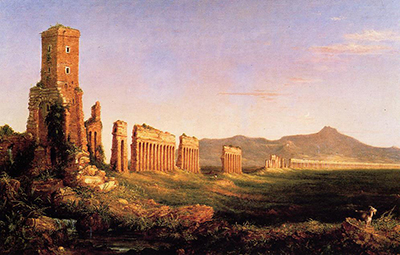In his Aqueduct near Rome painting, Cole's depicts a view of a partially collapsed ancient monumental water bridge in Saint Louis. He made the painting in 1832, and the portrait was commissioned later by Charles Lyman, a tourist who by that time was staying in Rome.
Thomas Cole was an American painter who was well known for his landscape and history paintings in the nineteenth century. His work was known for symbols that conveyed moralizing meanings of the American wilderness. The Aqueduct near Rome is an artwork that symbolizes the rise and fall of an empire in the Roman countryside. The composition of Cole's painting divides the landscape into three main parts, the front, middle, and far background. The crumbling bridge recedes from the right front end while the Sabine hills and mount Albano are on the far end horizon. Part of the aqueduct is broken into fragments making the structure resemble a fence.
A decayed watchtower Tor Fiscale, rests on the right side of the broken monument, with weeds growing in its masonry walls. Underneath there is a pile of broken bricks that seems to be gathering plants over time. In the foreground, there is a skull indicating the ultimate end of life and bringing a feeling of sadness. Adjacent, a solitary goat, is standing on the top of a rock. A crescent-shaped moon hangs on the mountain top fainted by sunlight that is coming from the right side. Finally, a few patches of clouds can be seen on the skies bringing a balance in the whole composition.
In his deliberate arrangement, Cole is suggesting a warning about the decline in imperial culture by urging his country to avoid such destruction. Cole used to do his paintings with the help of oil sketches and drawings. He used the impasto technique to make the muddy-colored picture. Cole used a brush to make the visible strokes and applied paint thickly in the painting. The image is dark with black and brown colors dominating the art except in a few areas where there is bright yellow and white.
Thomas Cole's visit to Italy occupies a special place. He did not only go to the countryside to gather artistic works for paintings but also visited locations for their historical dimensions. Through his composition, he tried to capture the atmosphere of sceneries and topographical conditions. He produced diverse ancient truths conditioned with colors on canvases. In the Detroit Institute of Art, more than two thousand five hundred of Cole's sketches are displayed there. One of his most famous works is A View from Mount Etna - Europe's tallest mountain with an active volcano. Cole inspired other American painters of his generation like Frederic Edwin Church through his work. He learned painting skills through other painter’s images and also reading books. Cole was the best-known American artist of his time.




